Numeracy and Data Analysis: Electricity Bill Project
VerifiedAdded on 2023/01/11
|12
|1554
|47
Report
AI Summary
This report presents a data analysis of electricity bills, covering various aspects of data handling and interpretation. The analysis begins with the arrangement of bill data in a tabular format, followed by the presentation of this data using line and bar charts for visual representation. The report then delves into statistical calculations, including the mean, mode, median, range, and standard deviation of the bill amounts. Furthermore, a linear forecasting model (y = mx + c) is employed to predict future bill values, with calculations for the slope (m) and intercept (c) of the model. The report concludes with forecasted values for specific months, providing insights into potential future electricity costs and demonstrating the practical application of data analysis techniques.

Numeracy and data analysis
Paraphrase This Document
Need a fresh take? Get an instant paraphrase of this document with our AI Paraphraser
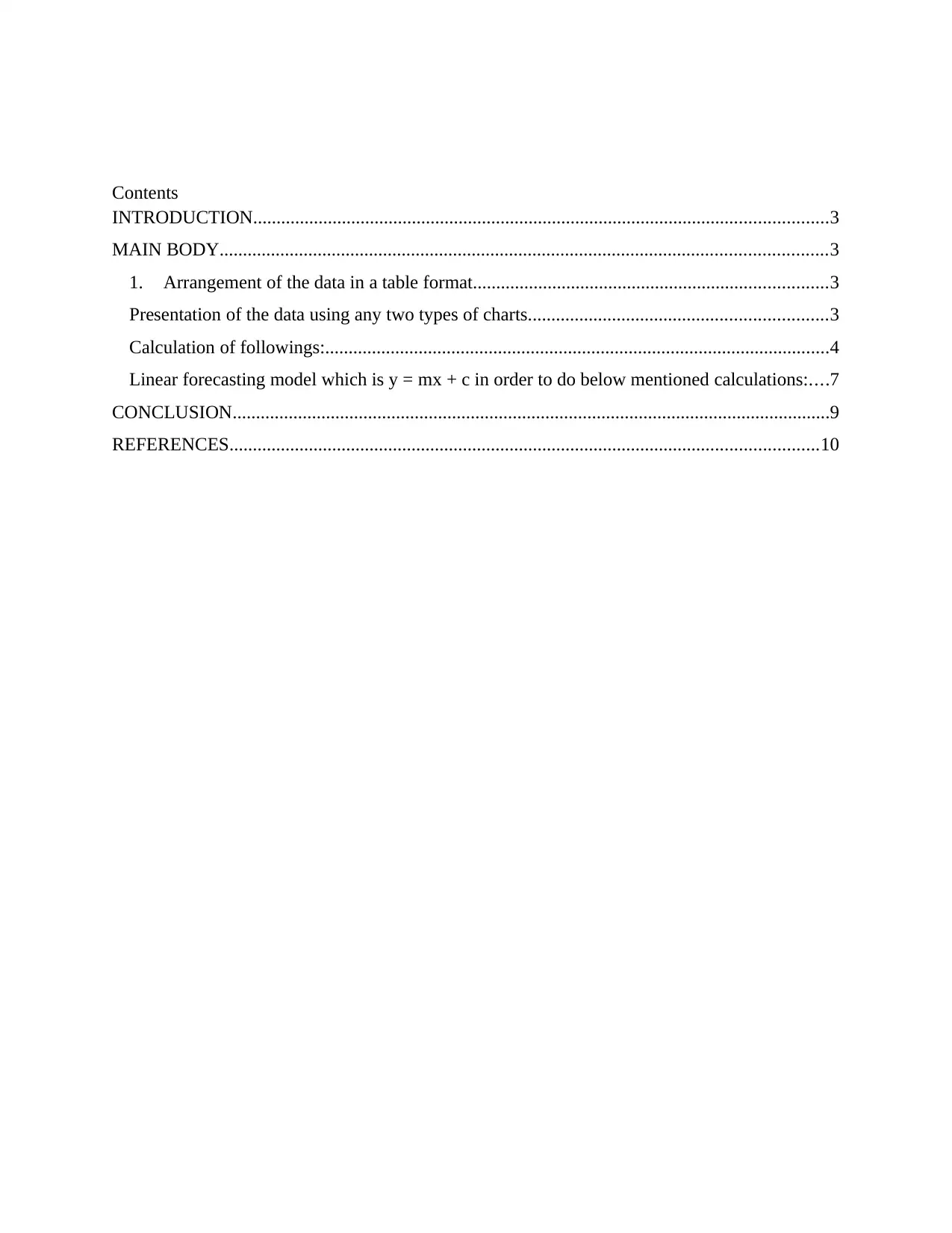
Contents
INTRODUCTION...........................................................................................................................3
MAIN BODY..................................................................................................................................3
1. Arrangement of the data in a table format............................................................................3
Presentation of the data using any two types of charts................................................................3
Calculation of followings:............................................................................................................4
Linear forecasting model which is y = mx + c in order to do below mentioned calculations:....7
CONCLUSION................................................................................................................................9
REFERENCES..............................................................................................................................10
INTRODUCTION...........................................................................................................................3
MAIN BODY..................................................................................................................................3
1. Arrangement of the data in a table format............................................................................3
Presentation of the data using any two types of charts................................................................3
Calculation of followings:............................................................................................................4
Linear forecasting model which is y = mx + c in order to do below mentioned calculations:....7
CONCLUSION................................................................................................................................9
REFERENCES..............................................................................................................................10
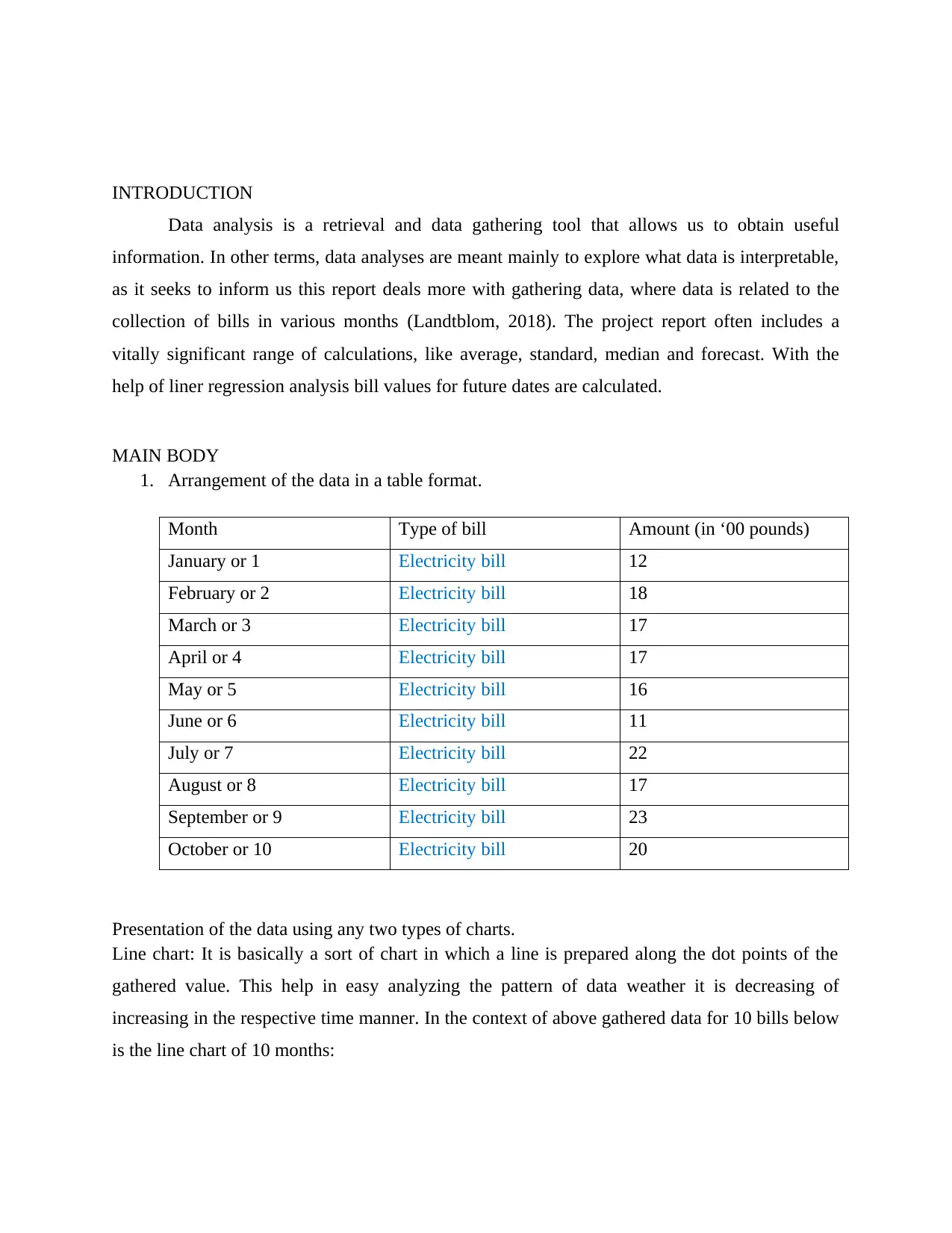
INTRODUCTION
Data analysis is a retrieval and data gathering tool that allows us to obtain useful
information. In other terms, data analyses are meant mainly to explore what data is interpretable,
as it seeks to inform us this report deals more with gathering data, where data is related to the
collection of bills in various months (Landtblom, 2018). The project report often includes a
vitally significant range of calculations, like average, standard, median and forecast. With the
help of liner regression analysis bill values for future dates are calculated.
MAIN BODY
1. Arrangement of the data in a table format.
Month Type of bill Amount (in ‘00 pounds)
January or 1 Electricity bill 12
February or 2 Electricity bill 18
March or 3 Electricity bill 17
April or 4 Electricity bill 17
May or 5 Electricity bill 16
June or 6 Electricity bill 11
July or 7 Electricity bill 22
August or 8 Electricity bill 17
September or 9 Electricity bill 23
October or 10 Electricity bill 20
Presentation of the data using any two types of charts.
Line chart: It is basically a sort of chart in which a line is prepared along the dot points of the
gathered value. This help in easy analyzing the pattern of data weather it is decreasing of
increasing in the respective time manner. In the context of above gathered data for 10 bills below
is the line chart of 10 months:
Data analysis is a retrieval and data gathering tool that allows us to obtain useful
information. In other terms, data analyses are meant mainly to explore what data is interpretable,
as it seeks to inform us this report deals more with gathering data, where data is related to the
collection of bills in various months (Landtblom, 2018). The project report often includes a
vitally significant range of calculations, like average, standard, median and forecast. With the
help of liner regression analysis bill values for future dates are calculated.
MAIN BODY
1. Arrangement of the data in a table format.
Month Type of bill Amount (in ‘00 pounds)
January or 1 Electricity bill 12
February or 2 Electricity bill 18
March or 3 Electricity bill 17
April or 4 Electricity bill 17
May or 5 Electricity bill 16
June or 6 Electricity bill 11
July or 7 Electricity bill 22
August or 8 Electricity bill 17
September or 9 Electricity bill 23
October or 10 Electricity bill 20
Presentation of the data using any two types of charts.
Line chart: It is basically a sort of chart in which a line is prepared along the dot points of the
gathered value. This help in easy analyzing the pattern of data weather it is decreasing of
increasing in the respective time manner. In the context of above gathered data for 10 bills below
is the line chart of 10 months:
⊘ This is a preview!⊘
Do you want full access?
Subscribe today to unlock all pages.

Trusted by 1+ million students worldwide
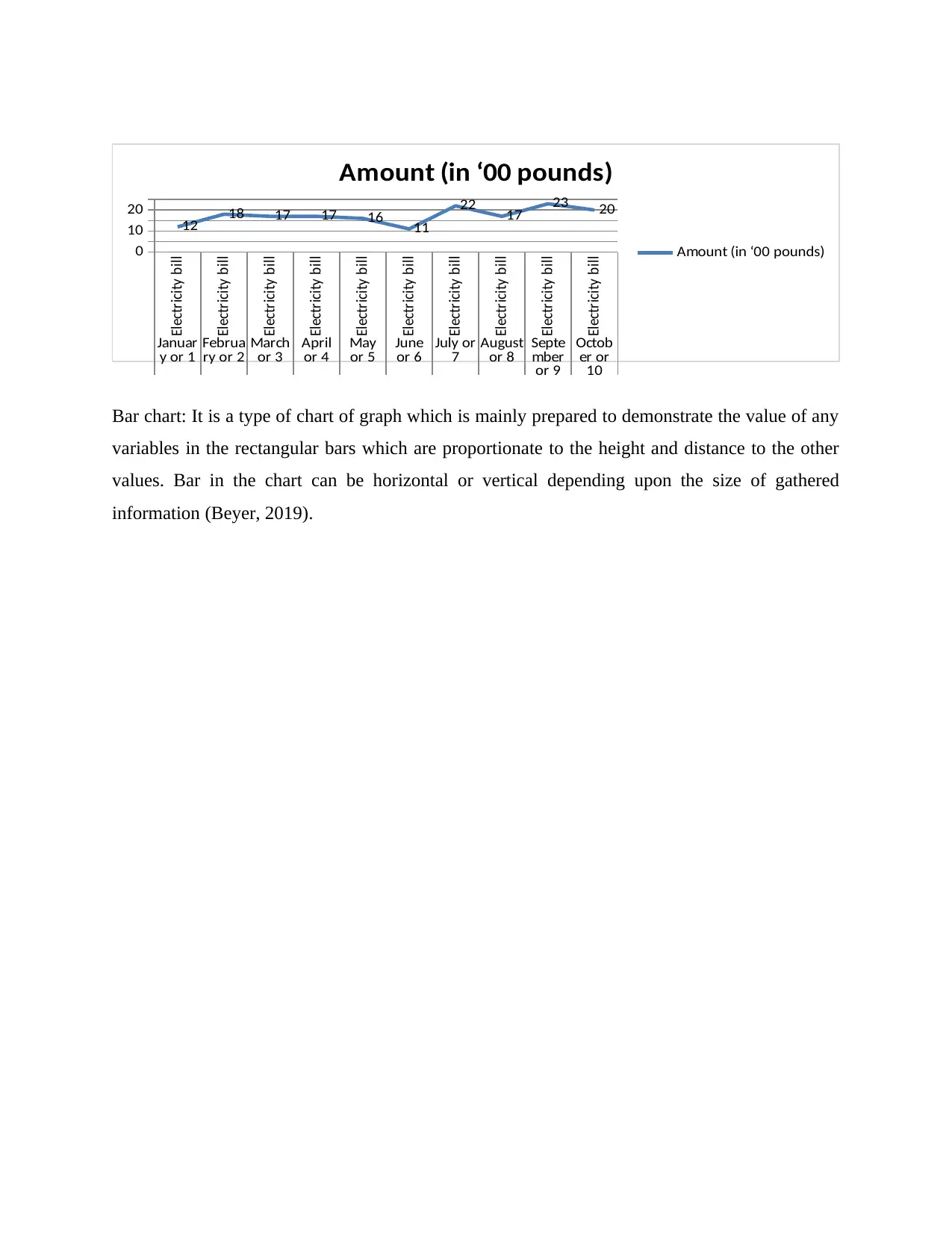
Electricity bill
Electricity bill
Electricity bill
Electricity bill
Electricity bill
Electricity bill
Electricity bill
Electricity bill
Electricity bill
Electricity bill
Januar
y or 1 Februa
ry or 2 March
or 3 April
or 4 May
or 5 June
or 6 July or
7 August
or 8 Septe
mber
or 9
Octob
er or
10
0
10
20
12 18 17 17 16 11
22 17 23 20
Amount (in ‘00 pounds)
Amount (in ‘00 pounds)
Bar chart: It is a type of chart of graph which is mainly prepared to demonstrate the value of any
variables in the rectangular bars which are proportionate to the height and distance to the other
values. Bar in the chart can be horizontal or vertical depending upon the size of gathered
information (Beyer, 2019).
Electricity bill
Electricity bill
Electricity bill
Electricity bill
Electricity bill
Electricity bill
Electricity bill
Electricity bill
Electricity bill
Januar
y or 1 Februa
ry or 2 March
or 3 April
or 4 May
or 5 June
or 6 July or
7 August
or 8 Septe
mber
or 9
Octob
er or
10
0
10
20
12 18 17 17 16 11
22 17 23 20
Amount (in ‘00 pounds)
Amount (in ‘00 pounds)
Bar chart: It is a type of chart of graph which is mainly prepared to demonstrate the value of any
variables in the rectangular bars which are proportionate to the height and distance to the other
values. Bar in the chart can be horizontal or vertical depending upon the size of gathered
information (Beyer, 2019).
Paraphrase This Document
Need a fresh take? Get an instant paraphrase of this document with our AI Paraphraser
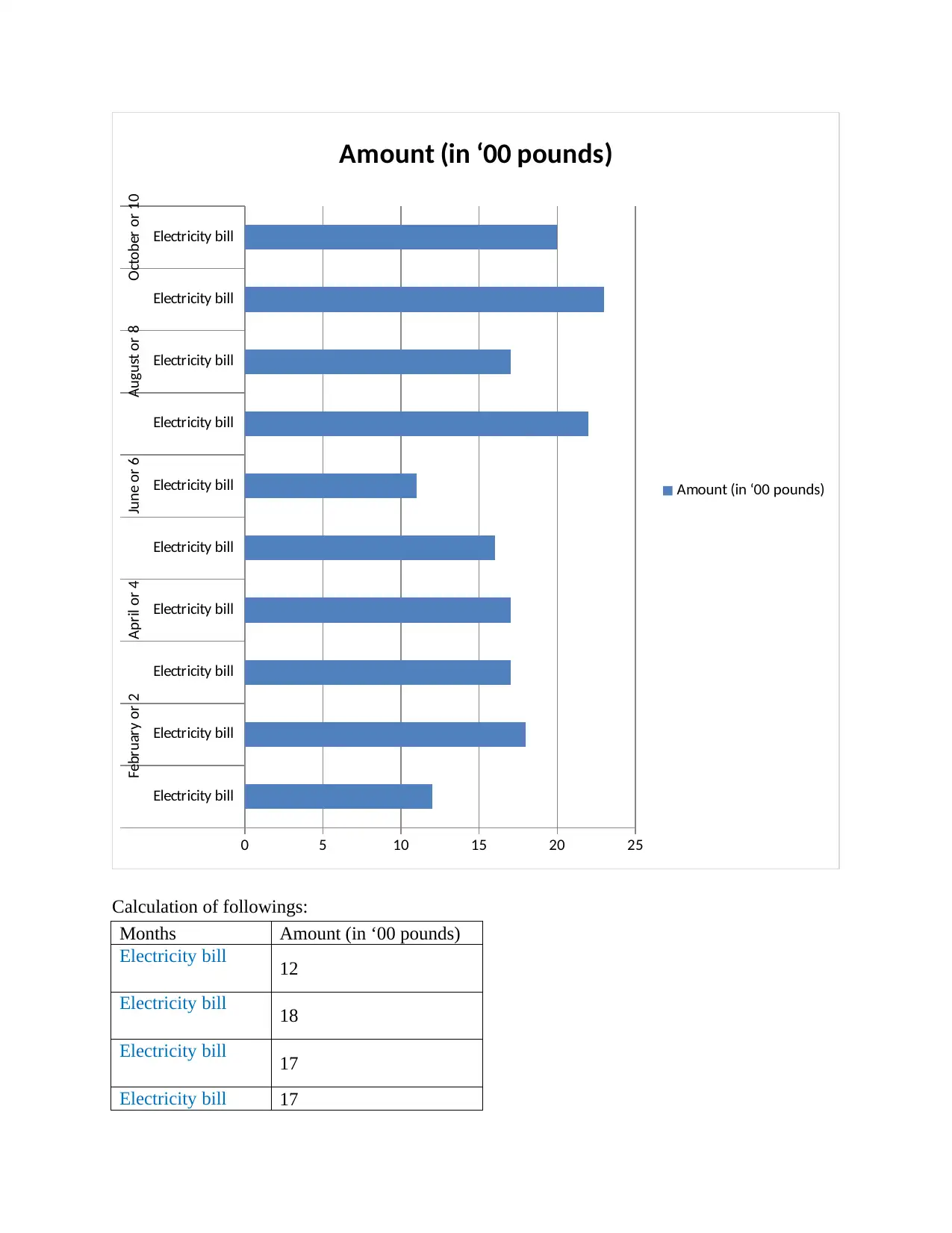
Electricity bill
Electricity bill
Electricity bill
Electricity bill
Electricity bill
Electricity bill
Electricity bill
Electricity bill
Electricity bill
Electricity bill
February or 2 April or 4 June or 6 August or 8 October or 10
0 5 10 15 20 25
Amount (in ‘00 pounds)
Amount (in ‘00 pounds)
Calculation of followings:
Months Amount (in ‘00 pounds)
Electricity bill 12
Electricity bill 18
Electricity bill 17
Electricity bill 17
Electricity bill
Electricity bill
Electricity bill
Electricity bill
Electricity bill
Electricity bill
Electricity bill
Electricity bill
Electricity bill
February or 2 April or 4 June or 6 August or 8 October or 10
0 5 10 15 20 25
Amount (in ‘00 pounds)
Amount (in ‘00 pounds)
Calculation of followings:
Months Amount (in ‘00 pounds)
Electricity bill 12
Electricity bill 18
Electricity bill 17
Electricity bill 17
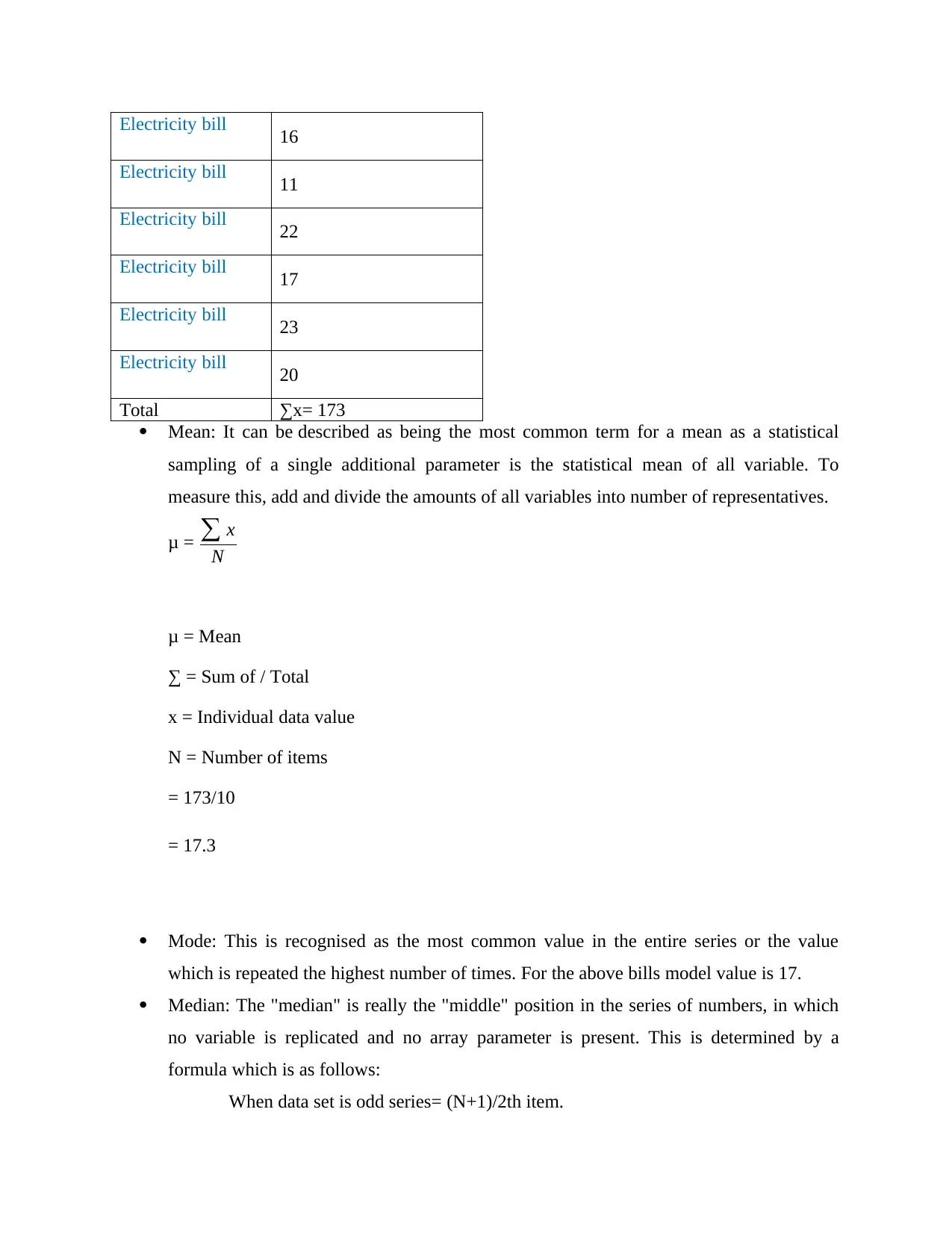
Electricity bill 16
Electricity bill 11
Electricity bill 22
Electricity bill 17
Electricity bill 23
Electricity bill 20
Total ∑x= 173
Mean: It can be described as being the most common term for a mean as a statistical
sampling of a single additional parameter is the statistical mean of all variable. To
measure this, add and divide the amounts of all variables into number of representatives.
μ = ∑ x
N
μ = Mean
∑ = Sum of / Total
x = Individual data value
N = Number of items
= 173/10
= 17.3
Mode: This is recognised as the most common value in the entire series or the value
which is repeated the highest number of times. For the above bills model value is 17.
Median: The "median" is really the "middle" position in the series of numbers, in which
no variable is replicated and no array parameter is present. This is determined by a
formula which is as follows:
When data set is odd series= (N+1)/2th item.
Electricity bill 11
Electricity bill 22
Electricity bill 17
Electricity bill 23
Electricity bill 20
Total ∑x= 173
Mean: It can be described as being the most common term for a mean as a statistical
sampling of a single additional parameter is the statistical mean of all variable. To
measure this, add and divide the amounts of all variables into number of representatives.
μ = ∑ x
N
μ = Mean
∑ = Sum of / Total
x = Individual data value
N = Number of items
= 173/10
= 17.3
Mode: This is recognised as the most common value in the entire series or the value
which is repeated the highest number of times. For the above bills model value is 17.
Median: The "median" is really the "middle" position in the series of numbers, in which
no variable is replicated and no array parameter is present. This is determined by a
formula which is as follows:
When data set is odd series= (N+1)/2th item.
⊘ This is a preview!⊘
Do you want full access?
Subscribe today to unlock all pages.

Trusted by 1+ million students worldwide
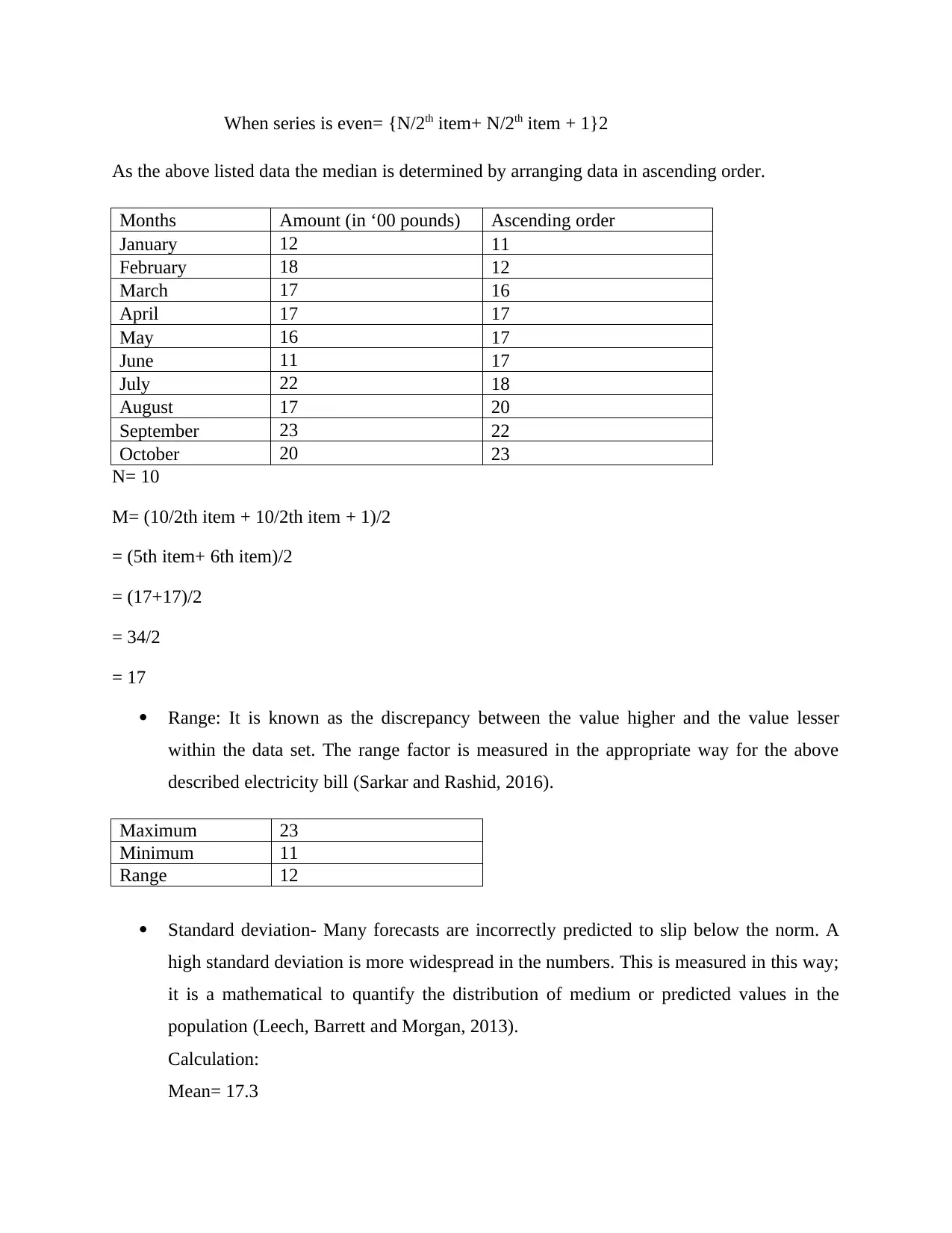
When series is even= {N/2th item+ N/2th item + 1}2
As the above listed data the median is determined by arranging data in ascending order.
Months Amount (in ‘00 pounds) Ascending order
January 12 11
February 18 12
March 17 16
April 17 17
May 16 17
June 11 17
July 22 18
August 17 20
September 23 22
October 20 23
N= 10
M= (10/2th item + 10/2th item + 1)/2
= (5th item+ 6th item)/2
= (17+17)/2
= 34/2
= 17
Range: It is known as the discrepancy between the value higher and the value lesser
within the data set. The range factor is measured in the appropriate way for the above
described electricity bill (Sarkar and Rashid, 2016).
Maximum 23
Minimum 11
Range 12
Standard deviation- Many forecasts are incorrectly predicted to slip below the norm. A
high standard deviation is more widespread in the numbers. This is measured in this way;
it is a mathematical to quantify the distribution of medium or predicted values in the
population (Leech, Barrett and Morgan, 2013).
Calculation:
Mean= 17.3
As the above listed data the median is determined by arranging data in ascending order.
Months Amount (in ‘00 pounds) Ascending order
January 12 11
February 18 12
March 17 16
April 17 17
May 16 17
June 11 17
July 22 18
August 17 20
September 23 22
October 20 23
N= 10
M= (10/2th item + 10/2th item + 1)/2
= (5th item+ 6th item)/2
= (17+17)/2
= 34/2
= 17
Range: It is known as the discrepancy between the value higher and the value lesser
within the data set. The range factor is measured in the appropriate way for the above
described electricity bill (Sarkar and Rashid, 2016).
Maximum 23
Minimum 11
Range 12
Standard deviation- Many forecasts are incorrectly predicted to slip below the norm. A
high standard deviation is more widespread in the numbers. This is measured in this way;
it is a mathematical to quantify the distribution of medium or predicted values in the
population (Leech, Barrett and Morgan, 2013).
Calculation:
Mean= 17.3
Paraphrase This Document
Need a fresh take? Get an instant paraphrase of this document with our AI Paraphraser
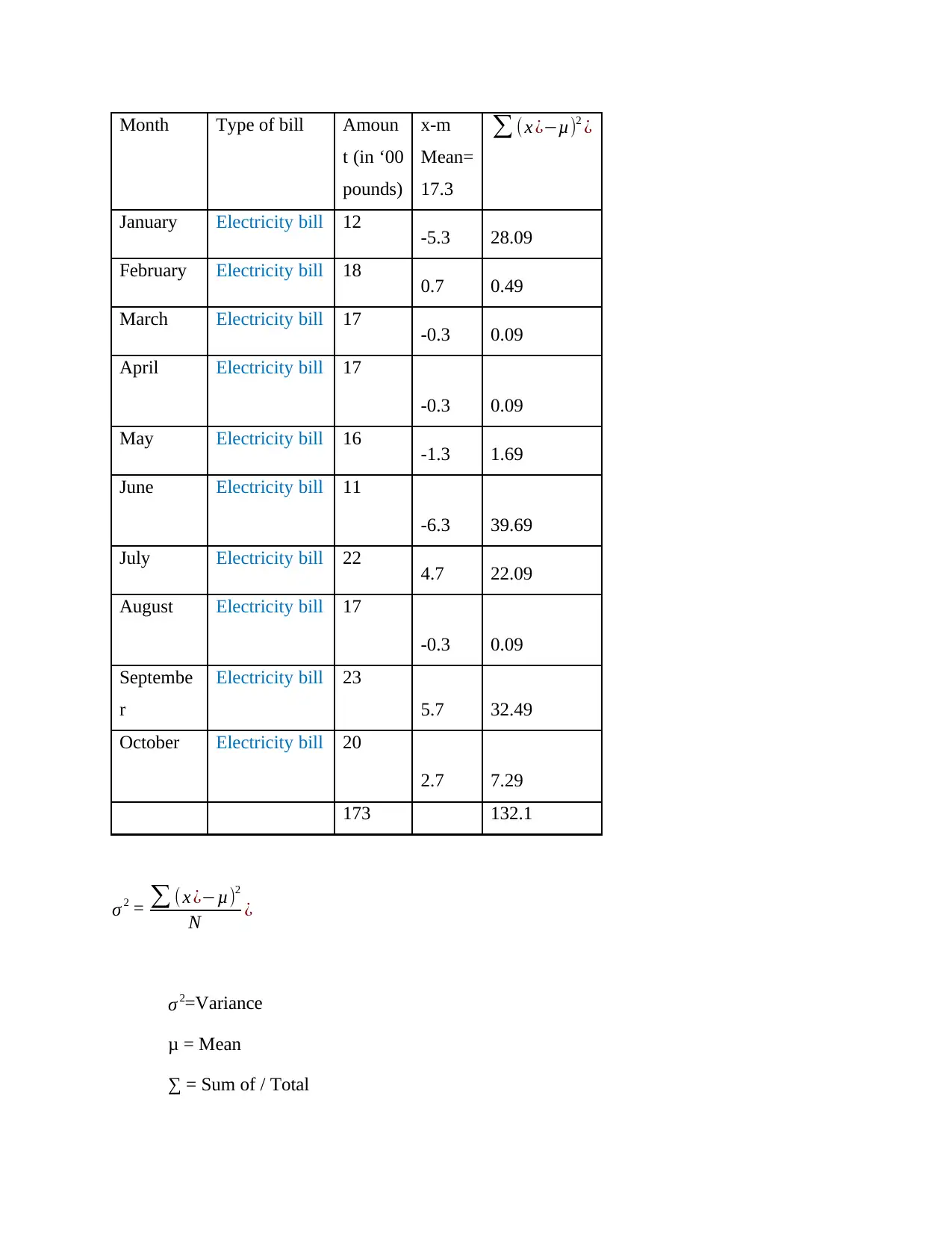
Month Type of bill Amoun
t (in ‘00
pounds)
x-m
Mean=
17.3
∑ (x ¿−μ)2 ¿
January Electricity bill 12 -5.3 28.09
February Electricity bill 18 0.7 0.49
March Electricity bill 17 -0.3 0.09
April Electricity bill 17
-0.3 0.09
May Electricity bill 16 -1.3 1.69
June Electricity bill 11
-6.3 39.69
July Electricity bill 22 4.7 22.09
August Electricity bill 17
-0.3 0.09
Septembe
r
Electricity bill 23
5.7 32.49
October Electricity bill 20
2.7 7.29
173 132.1
σ 2 = ∑ ( x ¿−μ)2
N ¿
σ 2=Variance
μ = Mean
∑ = Sum of / Total
t (in ‘00
pounds)
x-m
Mean=
17.3
∑ (x ¿−μ)2 ¿
January Electricity bill 12 -5.3 28.09
February Electricity bill 18 0.7 0.49
March Electricity bill 17 -0.3 0.09
April Electricity bill 17
-0.3 0.09
May Electricity bill 16 -1.3 1.69
June Electricity bill 11
-6.3 39.69
July Electricity bill 22 4.7 22.09
August Electricity bill 17
-0.3 0.09
Septembe
r
Electricity bill 23
5.7 32.49
October Electricity bill 20
2.7 7.29
173 132.1
σ 2 = ∑ ( x ¿−μ)2
N ¿
σ 2=Variance
μ = Mean
∑ = Sum of / Total
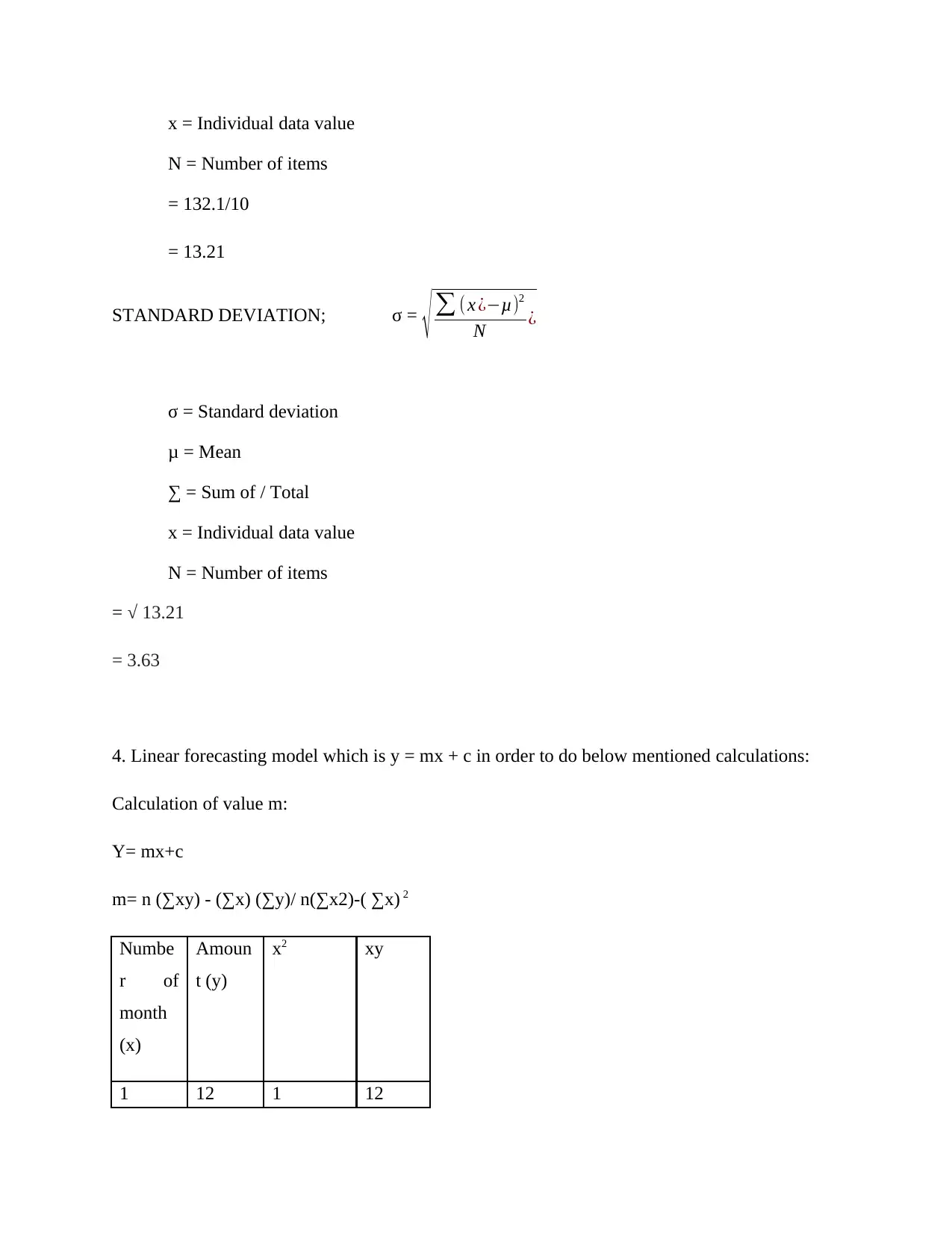
x = Individual data value
N = Number of items
= 132.1/10
= 13.21
STANDARD DEVIATION; σ = √ ∑ (x ¿−μ)2
N ¿
σ = Standard deviation
μ = Mean
∑ = Sum of / Total
x = Individual data value
N = Number of items
= √ 13.21
= 3.63
4. Linear forecasting model which is y = mx + c in order to do below mentioned calculations:
Calculation of value m:
Y= mx+c
m= n (∑xy) - (∑x) (∑y)/ n(∑x2)-( ∑x) 2
Numbe
r of
month
(x)
Amoun
t (y)
x2 xy
1 12 1 12
N = Number of items
= 132.1/10
= 13.21
STANDARD DEVIATION; σ = √ ∑ (x ¿−μ)2
N ¿
σ = Standard deviation
μ = Mean
∑ = Sum of / Total
x = Individual data value
N = Number of items
= √ 13.21
= 3.63
4. Linear forecasting model which is y = mx + c in order to do below mentioned calculations:
Calculation of value m:
Y= mx+c
m= n (∑xy) - (∑x) (∑y)/ n(∑x2)-( ∑x) 2
Numbe
r of
month
(x)
Amoun
t (y)
x2 xy
1 12 1 12
⊘ This is a preview!⊘
Do you want full access?
Subscribe today to unlock all pages.

Trusted by 1+ million students worldwide
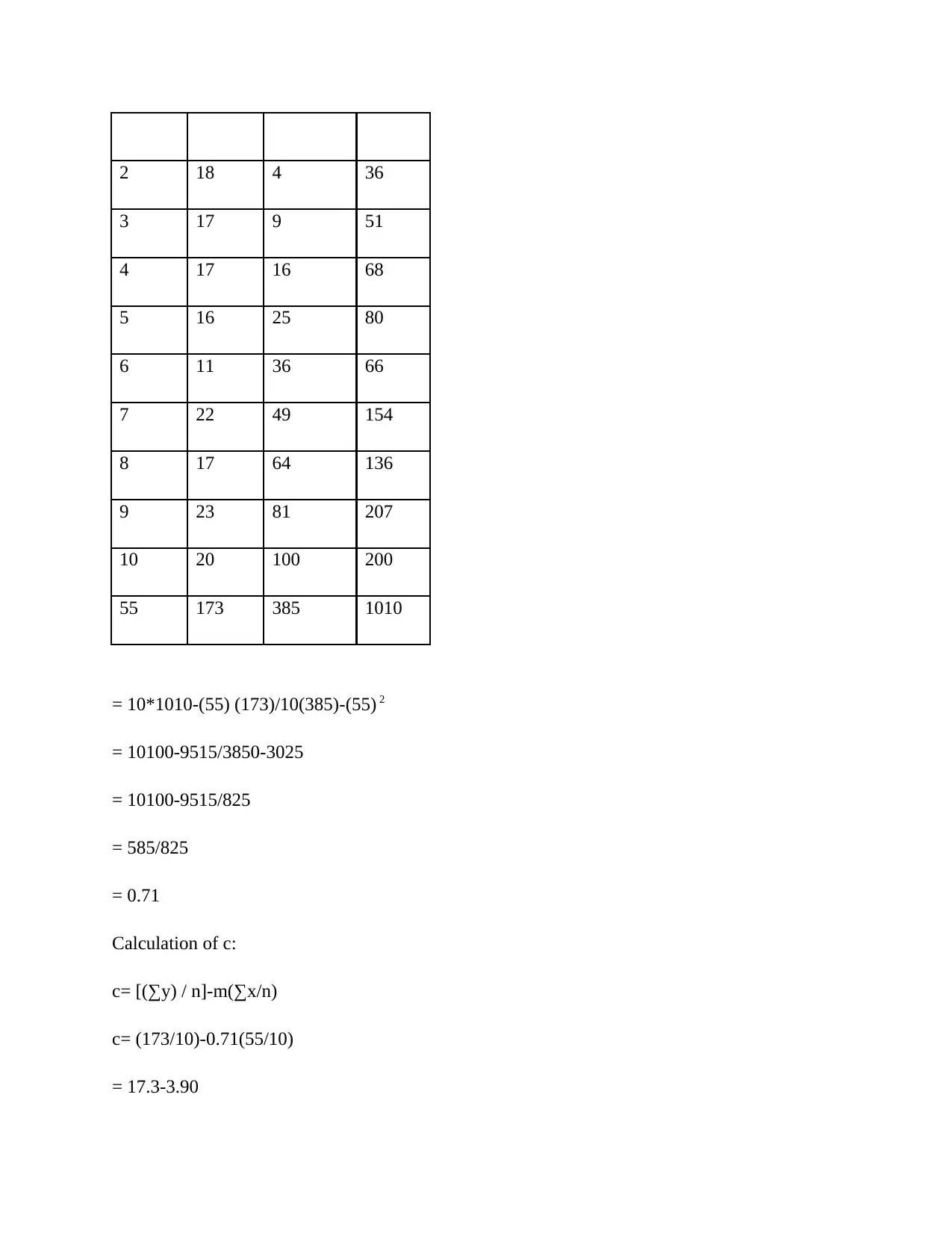
2 18 4 36
3 17 9 51
4 17 16 68
5 16 25 80
6 11 36 66
7 22 49 154
8 17 64 136
9 23 81 207
10 20 100 200
55 173 385 1010
= 10*1010-(55) (173)/10(385)-(55) 2
= 10100-9515/3850-3025
= 10100-9515/825
= 585/825
= 0.71
Calculation of c:
c= [(∑y) / n]-m(∑x/n)
c= (173/10)-0.71(55/10)
= 17.3-3.90
3 17 9 51
4 17 16 68
5 16 25 80
6 11 36 66
7 22 49 154
8 17 64 136
9 23 81 207
10 20 100 200
55 173 385 1010
= 10*1010-(55) (173)/10(385)-(55) 2
= 10100-9515/3850-3025
= 10100-9515/825
= 585/825
= 0.71
Calculation of c:
c= [(∑y) / n]-m(∑x/n)
c= (173/10)-0.71(55/10)
= 17.3-3.90
Paraphrase This Document
Need a fresh take? Get an instant paraphrase of this document with our AI Paraphraser
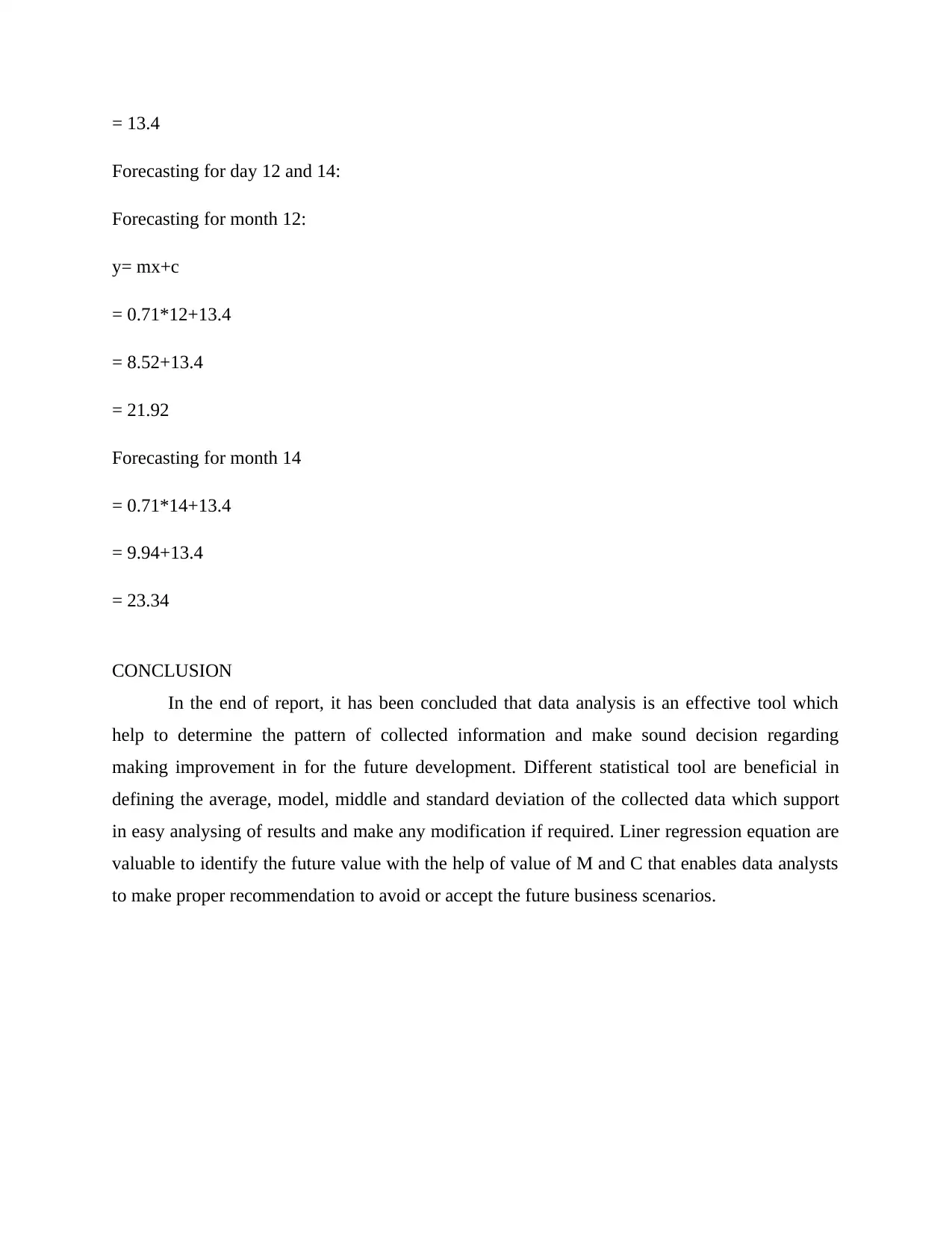
= 13.4
Forecasting for day 12 and 14:
Forecasting for month 12:
y= mx+c
= 0.71*12+13.4
= 8.52+13.4
= 21.92
Forecasting for month 14
= 0.71*14+13.4
= 9.94+13.4
= 23.34
CONCLUSION
In the end of report, it has been concluded that data analysis is an effective tool which
help to determine the pattern of collected information and make sound decision regarding
making improvement in for the future development. Different statistical tool are beneficial in
defining the average, model, middle and standard deviation of the collected data which support
in easy analysing of results and make any modification if required. Liner regression equation are
valuable to identify the future value with the help of value of M and C that enables data analysts
to make proper recommendation to avoid or accept the future business scenarios.
Forecasting for day 12 and 14:
Forecasting for month 12:
y= mx+c
= 0.71*12+13.4
= 8.52+13.4
= 21.92
Forecasting for month 14
= 0.71*14+13.4
= 9.94+13.4
= 23.34
CONCLUSION
In the end of report, it has been concluded that data analysis is an effective tool which
help to determine the pattern of collected information and make sound decision regarding
making improvement in for the future development. Different statistical tool are beneficial in
defining the average, model, middle and standard deviation of the collected data which support
in easy analysing of results and make any modification if required. Liner regression equation are
valuable to identify the future value with the help of value of M and C that enables data analysts
to make proper recommendation to avoid or accept the future business scenarios.
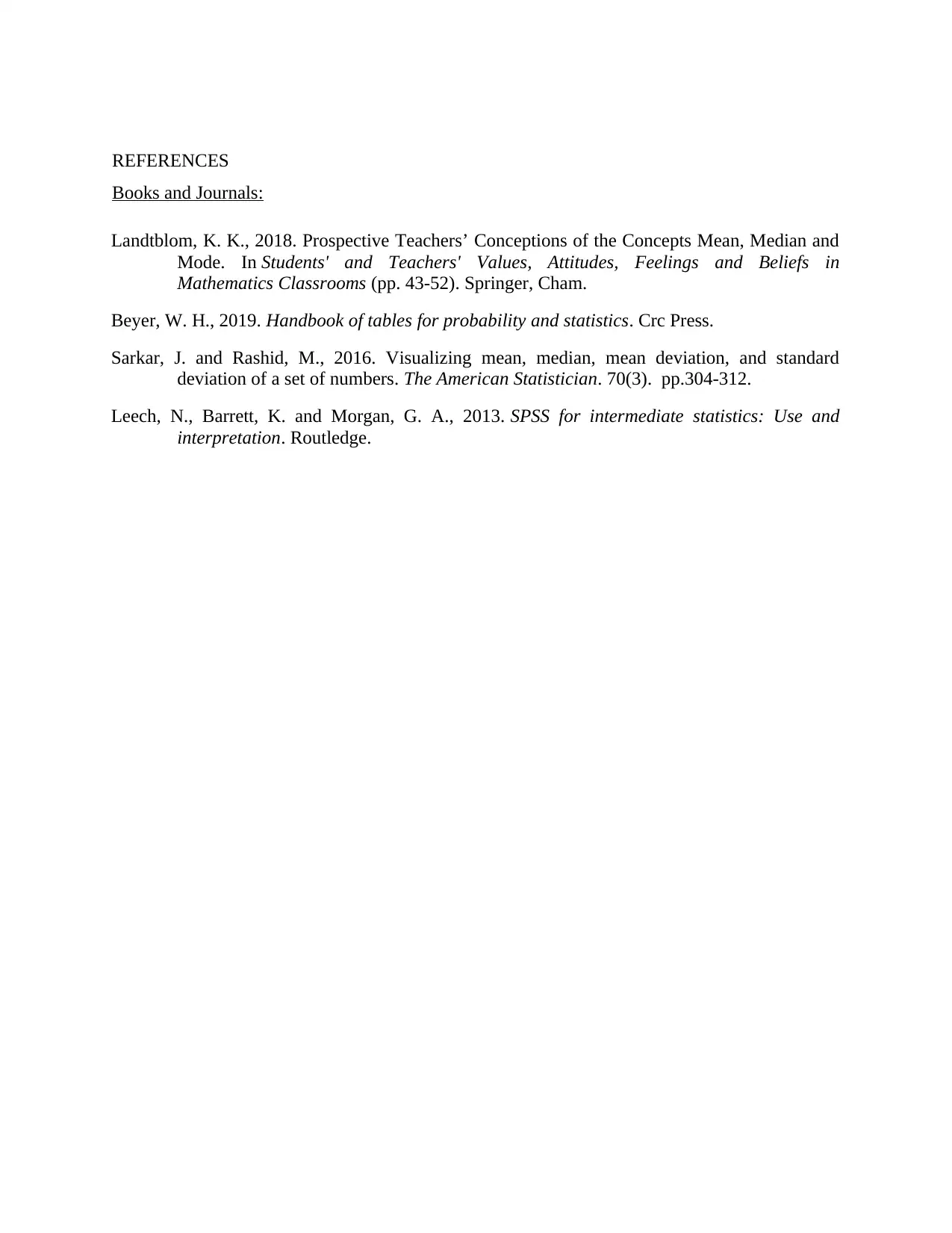
REFERENCES
Books and Journals:
Landtblom, K. K., 2018. Prospective Teachers’ Conceptions of the Concepts Mean, Median and
Mode. In Students' and Teachers' Values, Attitudes, Feelings and Beliefs in
Mathematics Classrooms (pp. 43-52). Springer, Cham.
Beyer, W. H., 2019. Handbook of tables for probability and statistics. Crc Press.
Sarkar, J. and Rashid, M., 2016. Visualizing mean, median, mean deviation, and standard
deviation of a set of numbers. The American Statistician. 70(3). pp.304-312.
Leech, N., Barrett, K. and Morgan, G. A., 2013. SPSS for intermediate statistics: Use and
interpretation. Routledge.
Books and Journals:
Landtblom, K. K., 2018. Prospective Teachers’ Conceptions of the Concepts Mean, Median and
Mode. In Students' and Teachers' Values, Attitudes, Feelings and Beliefs in
Mathematics Classrooms (pp. 43-52). Springer, Cham.
Beyer, W. H., 2019. Handbook of tables for probability and statistics. Crc Press.
Sarkar, J. and Rashid, M., 2016. Visualizing mean, median, mean deviation, and standard
deviation of a set of numbers. The American Statistician. 70(3). pp.304-312.
Leech, N., Barrett, K. and Morgan, G. A., 2013. SPSS for intermediate statistics: Use and
interpretation. Routledge.
⊘ This is a preview!⊘
Do you want full access?
Subscribe today to unlock all pages.

Trusted by 1+ million students worldwide
1 out of 12
Related Documents
Your All-in-One AI-Powered Toolkit for Academic Success.
+13062052269
info@desklib.com
Available 24*7 on WhatsApp / Email
![[object Object]](/_next/static/media/star-bottom.7253800d.svg)
Unlock your academic potential
Copyright © 2020–2025 A2Z Services. All Rights Reserved. Developed and managed by ZUCOL.




